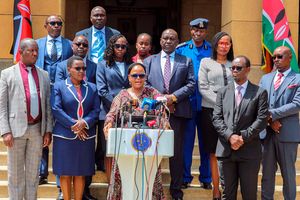
Extended families on both sides get to meet and know each other during the ruracio ceremony.
We had a traditional wedding (ruracio) last year. My husband suggested I move in because we were now officially married.
We never signed any documents and I can’t help but wonder, is this marriage legally binding?
Ruracio is an acceptable and recognised traditional practice within the marriage continuum observed and carried out by certain communities, which the Kenyan Constitution backs.
However, Articles 11 and 46, which are the provisions that back it, must be read together with Article 2 Clause 4, considering caution on constitutional inconsistencies.
In the first provision, culture is recognised as the foundational pillar of the nation, with communities having the freedom to promote their own through expressions and traditional celebrations, amongst other mechanisms.
Even further, in the gamut constituting marriages, ruracio in the spirit of Article 46 Clauses 1 and 2 on cultural practices is one the many acts that demonstrate intention and commitment to pursue the common goal of one becoming wife, while another the husband.
This freedom and choice to practice are limited by the provisions given by Clause 4 of Article 2, which tethers it to the consistency of the Constitution.
It directly warns that any act, omission, and law, whether customary or otherwise, must not contravene the Constitution. However, the invalidity in such cases is limited to the magnitude of the inconsistency.
The Marriage Act of 2014 provides the operational details that make Article 45. It provides for customary marriages as one of the five legally recognised in the country’s legal and social system.
The intention and commitment to marry do not necessarily transition into marriage.
Going by the Supreme Court decision in Petition 9 of 2021, in Paragraph 11, it was cited that there are increased relationships where couples cohabit with no intention whatsoever of contracting marriage.
The Marriage Act of 2014 seemingly aimed to cure part of this mischief, especially clarity of who belonged to matrimonial confinement. Therefore, fulfilling a few customarily accepted rituals defined by specific cultural community parameters is mandatory.
Section 43, therefore, commands that such unions should be celebrated as per the customs of the communities of either party intending to tie the knot.
Further, subsection 2 states that the same must be fulfilled in communities where dowry payment is an act that witnesses and cements the agreement of two accepting to stay together to become known as husband and wife.
The section of this law adds that a token of the dowry shall be sufficient to prove a customary marriage.
Nonetheless, for those who finalise this process required by their faiths and places of worship for a religious celebration, this must be done.
For a customary marriage to be legal and not invite the court to test the presumption of its existence, should such circumstances arise in the future, where contestation is often over estate distribution of a likely deceased spouse or property sharing in divorce scenarios, Section 44 of the Marriage Act must be complied with.
The parties, being husband and wife, shall notify the Registrar of Marriages within three months after completion of the relevant ceremonies or actions within their community confer them the marriage status.
As provided by Sections 45 and 25, the notification must consist of the specific customary law applied in their marriage: a written declaration by the parties indicating necessary customary requirements were fulfilled.
Additionally, the notification must confirm that the parties to the marriage are adults and have entered the institution upon attaining the age of majority.
Besides, the notification should be evidence that the union is between persons not within a prohibited marriage relationship, alongside a declaration that the parties consented.
Justice Wendoh, in case number 133 of 2019, while dismissing an appellant’s claim of being the wife of the deceased said: “In my considered view, it has not been demonstrated to the required standard that the Appellant and the deceased were of the repute of husband and wife. It is not clear to this court, given the allegation that the Appellant shared a house with the first wife as to whether there was actual cohabitation.
No property was acquired by the two jointly, performance of the ceremony of the marriage is riddled with many uncertainties, and on the last days of the deceased, it was clear that the Appellant never participated in the business of looking after him or contributing funds towards his medical bills.”
For the marriage to be legally binding, it must fulfil all the acceptable cultural parameters that amount to a recognisable union.











